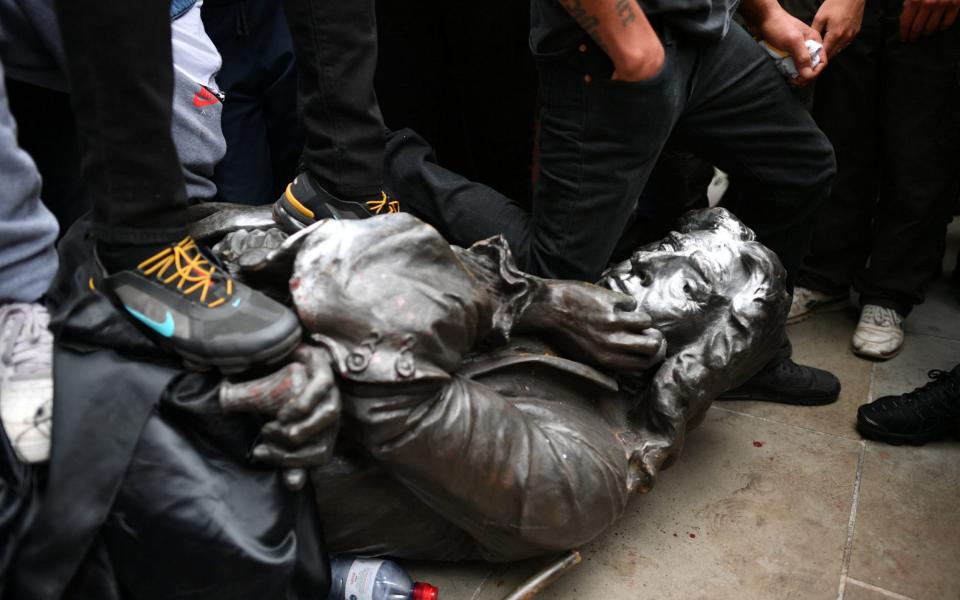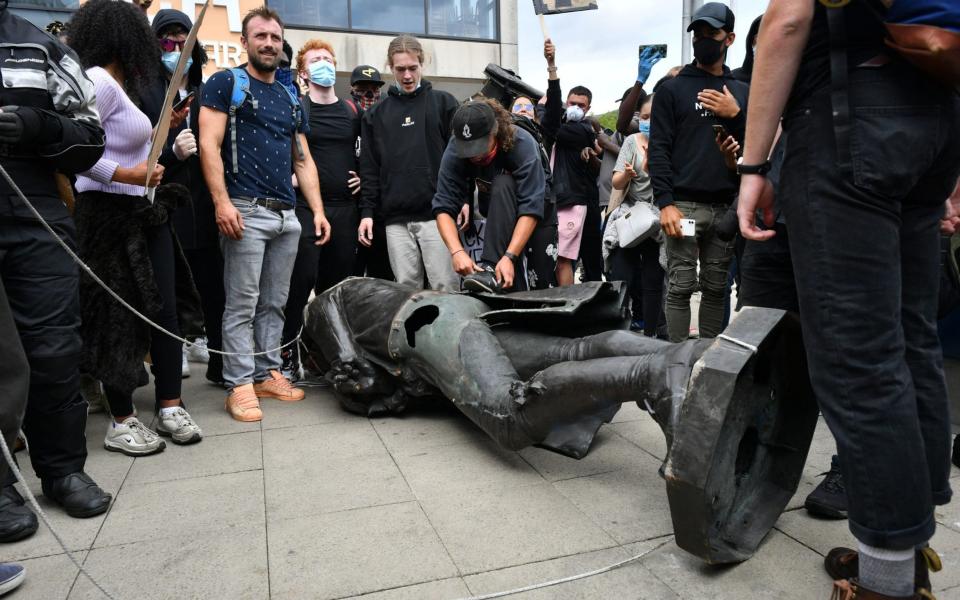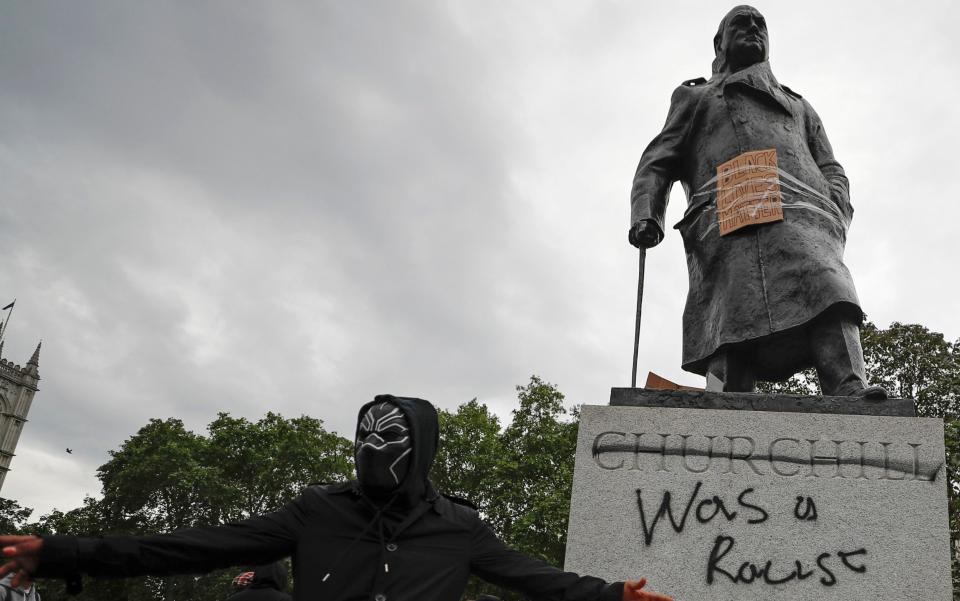Statue of slave trader Edward Colston pulled down and thrown into harbour by Bristol protesters

Police in Bristol are hunting a mob who toppled a 125-year-old statue of the slave trader, Edward Colston, before dumping it in the harbour during a Black Lives Matter march.
The incident came as an estimated 10,000 people gathered in the city to demonstrate against the killing in the United States in police custody of the unarmed black man, George Floyd.
After marching to the statue, which has been at the centre of a long running debate in Bristol, the protestors attached ropes to the bronze figure before pulling it from its stone pedestal.
Cheering loudly and dancing on the figure the group, many of whom were white, then dragged it to the nearby quay where it was thrown into the water.
Priti Patel, the Home Secretary, condemned the actions of the group and said such acts of vandalism were a “distraction from the cause in which people are actually protesting about”.
One demonstrator was photographed leaning on the statue's neck with his knee in an imitation of the choke hold used by US police against George Floyd last month.

#Bristol statue of Edward Colston has been pulled down and pushed into the harbour during the #BlackLivesMattter march pic.twitter.com/ME1yxAhw7G
— BBC Radio Bristol (@bbcrb) June 7, 2020
Avon and Somerset Police superintendent Andy Bennett said 10,000 people had attended the Black Lives Matter demonstration in Bristol and the majority did so "peacefully".
He said: "The Black Lives Matter demonstration in Bristol was attended by an estimated 10,000 people. The vast majority of those who came to voice their concerns about racial inequality and injustice did so peacefully and respectfully. The ongoing coronavirus pandemic added a different dynamic to what was always going to be a challenging policing operation.
"And I'd like to thank the organisers for their efforts to encourage demonstrators to follow Government guidance - a message which many clearly took on board, doing their best to socially distance despite the large crowds. Keeping the public safe was our greatest priority and thankfully there were no instances of disorder and no arrests were made."
But he added officers would be seeking to identify protesters who pulled down a statue of slave trader Edward Colston.
"An investigation will be carried out to identify those involved and we're already collating footage of the incident," he said.
“You might wonder why we didn't intervene and why we just allowed people to put it in the docks we made a very tactical decision that to stop people from doing that act may have caused further disorder and we decided that the safest thing to do in terms of our policing tactics was to allow it to take place.
“Our policing style from the outset was low key, we were not able to get to the statue in time to protect it and once it had actually been toppled there was clearly a preplanned attempt to bring that down. They had grappling ropes and they had the right tools.
“So once it was down we made a decision the right thing to was to allow it to happen because what we did not want is tension.”

Colston's likeness had been the subject of an 11,000-strong petition to have it removed.
Protestor John McAllister, 71, tore down black bin bags used to hide the statue to denounce it in front of fellow protesters, before a rope was tied around it and used to pull it down.
Mr McAllister said: "It says 'erected by the citizens of Bristol, as a memorial to one of the most virtuous and wise sons of this city'.
"The man was a slave trader. He was generous to Bristol but it was off the back of slavery and it's absolutely despicable. It's an insult to the people of Bristol."
Edward Colston was involved in the Royal African Company, a trading company that was engaged in the slave trade in the 17th century.
The company is thought to have transported around 84,000 African men, women and children in the time Colston was involved.
Around 19,000 died on their journey to the Caribbean and the Americas.

In London a second day of protests saw Winston Churchill’s statue defaced with the word ‘racist’ daubed across the plinth.
Thousands of demonstrators ignored coronavirus health warnings for a second day to gather in towns and cities across the UK including London, Manchester and Bristol.
Metropolitan Police said 12 people were arrested and eight officers injured during Sunday's anti-racism demonstrations in central London.
Most of the arrests were related to public order offences while one was for criminal damage following an incident at the Cenotaph.
On Sunday evening, Prime Minister Boris Johnson tweeted: "People have a right to protest peacefully & while observing social distancing but they have no right to attack the police.
"These demonstrations have been subverted by thuggery - and they are a betrayal of the cause they purport to serve.
"Those responsible will be held to account."
People have a right to protest peacefully & while observing social distancing but they have no right to attack the police. These demonstrations have been subverted by thuggery - and they are a betrayal of the cause they purport to serve. Those responsible will be held to account.
— Boris Johnson #StayAlert (@BorisJohnson) June 7, 2020
It comes after Scotland Yard said 29 people were arrested and 14 officers were injured during clashes between police and protesters the day before.
On Saturday a largely peaceful march tuned ugly when a mob attacked police officers outside Downing Street.
They threw missiles including bicycles at mounted police officers and one female officer was badly hurt when her horse bolted and careered into a traffic light.
Almost 30 police officers have been hurt in recent days and the Met Commissioner, Cressida Dick, said the number of assaults had been “shocking and completely unacceptable”.
Sadiq Khan, the London Mayor, said: "The vast majority of protestors in London were peaceful. But this vital cause was badly let down by a tiny minority who turned violent and threw glass bottles and lit flares, endangering other protestors and injuring police officers.
“This is simply not acceptable, will not be tolerated and will not win the lasting and necessary change we desperately need to see.”

